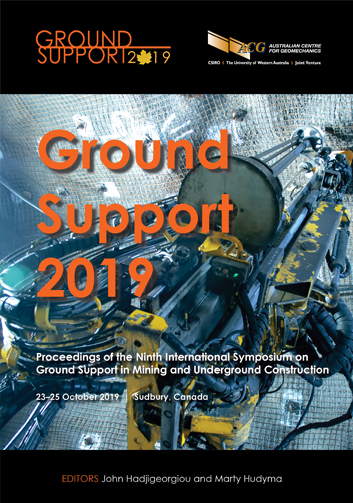Technologies of ground support monitoring in block caving operations

|
Authors: Dawn, T |
DOI https://doi.org/10.36487/ACG_rep/1925_06_Dawn
Cite As:
Dawn, T 2019, 'Technologies of ground support monitoring in block caving operations', in J Hadjigeorgiou & M Hudyma (eds), Ground Support 2019: Proceedings of the Ninth International Symposium on Ground Support in Mining and Underground Construction, Australian Centre for Geomechanics, Perth, pp. 109-122, https://doi.org/10.36487/ACG_rep/1925_06_Dawn
Abstract:
Block caving operations are increasing in popularity in the mining industry as companies are looking to extract large, deep orebodies faster and more economically. Underground mass mining methods, such as block caving, present several geotechnical hazards and risks that must be monitored using technology. Advances in geotechnical instrumentation have helped bring value to the operational and safety risks associated with block caving. There are two types of instrumentation, internal and external, that must be used in conjunction with one another to effectively monitor the geotechnical risks and ground support of the block cave. Internal monitoring of pore pressure, stress, deformation, load, and cave propagation will provide insight into the internal stability of the rock mass as well as provide leading indicators of potential failures. Key internal instrumentation would include Multipoint Borehole Extensometers (MPBX), in-place inclinometers (IPI), timedomain reflectometry (TDR), seismic monitoring, open borehole cameras, Networked Smart Markers, instrumented rock and cable bolts, embedment strain gauges, borehole and New Australian Tunnelling Method (NATM) pressure cells, borehole stressmeters, and piezometers. To corroborate the internal deformation and stress information, external instrumentation should be utilised to monitor the surface deformation within the underground workings as well as on the topographic surface. External instrumentation includes tape extensometers, laser distance sensors, prisms, crackmeters, LiDAR laser scanners, and satellite interferometric synthetic aperture radar (InSAR). When using these multiple instrumentation technologies together, one can have a better understanding of the mining-induced ground response, have more transparency in monitoring and handling risk, numerical model calibration, and ensure that the cave is operating at the highest level of safety and production levels.
Keywords: ground support, block caving, instrumentation, monitoring
References:
Butcher, R, Stacey, T & Joughin, W 2005, ‘Mud rushes and methods of combating them’, Journal of the South African Institute of Mining and Metallurgy, vol. 105, pp. 807–824.
Elexon Mining 2016a, Cave Tracker: Safe and Performing Block Cave Mines, brochure, viewed 8 April 2019,
Elexon Mining 2016b, Networked Smart Markers – Wireless Cave Back Monitoring, brochure, viewed 8 April 2019,
Geokon 2019a, Model 6150E MEMS Digital Addressable In-Place Inclinometer, fact sheet, viewed 8 April 2019,
Hudyma, M, Potvin, Y & Allison, D 2008, ‘Seismic monitoring of the Northparkes Lift 2 block cave - Part 2 production caving’, Journal of the South African Institute of Mining and Metallurgy, vol. 108, pp. 421–430.
La Rosa, D & Chen, D 1997, ‘Development of the Automated Cave Monitoring System at Northparkes Mines’, in H Gurgenci & M Hood (eds), Proceedings of the 4th International Symposium on Mine Mechanisation and Automation, Colorado School of Mines, Golden, pp. 35–43.
Laubscher, D 2003, Cave Mining Handbook, De Beers, Johannesburg.
Mine Design Technologies 2019, SMART Cable Bolt, Mine Design Technologies, Kingston, viewed 8 April 2019,
Mitri, H 2013, ‘Evaluation of rock support performance through instrumentation and monitoring of bolt axial load’, Proceedings of the 11th Underground Coal Operators’ Conference, The Australasian Institute of Mining and Metallurgy, Melbourne,
pp. 136–140.
Morton, K, Muresan, M & Ramsden, E 2008, ‘Importance of pore pressure monitoring in high walls’, Journal of the South African Institute of Mining and Metallurgy, vol. 108, pp. 661–667.
Vallejos, J, Basaure, K, Palma, S & Castro, R 2017, ‘Methodology for evaluation of mud rush risk in block caving mining’, Journal of the Southern African Institute of Mining and Metallurgy, vol. 117, pp. 1–7.
© Copyright 2025, Australian Centre for Geomechanics (ACG), The University of Western Australia. All rights reserved.
View copyright/legal information
Please direct any queries or error reports to repository-acg@uwa.edu.au
View copyright/legal information
Please direct any queries or error reports to repository-acg@uwa.edu.au